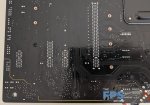Coming back to this for a couple of reasons (you can blame
@noko too).
First, the Aquantia NICs are basically not worth it. I'd take a Realtek crab-LAN controller if they made one in 10Gbit over these (which they don't... yet). Instead, I bay'ed an X550-T2 to toss in the bottom PCIe 3.0 x4 slot. Definitely a crap-shoot with used parts, but it can pay off too, and this one worked.
Main complaints with the Aquantias are that they like to decide that the network cable that is clearly connected suddenly isn't, and require a disable / enable cycle in the OS to 'find' the cable again. Side complaint is that I like TrueNAS (nee FreeNAS) and the stable BSD-based branch of that distro does not yet have the Aquantia driver built in yet, and won't, until they rebase (if ever!) on FreeBSD 13, which I believe hasn't actually been released yet.
The used Intel NIC seems to work fine so far. I got an X540-T2 for the fileserver since it is sharing the main PCIe x16 allocation from the CPU with an SAS controller which is PCIe 2.0, since the prices on used PCIe 3.0 controllers are pretty high still and they provide no advantage at my level with SATA drives.
So in summary... I've backed off of NICs as being a requirement for my desktop boards. At this point I pretty much feel that fan and RGB control are top of the list after having the basics covered, ideally just a solid VRM and non-retarded slot layout, as I'll carry my Intel NICs forward.
On the other hand, I'd really like the option to add more RAM easily, and I am starting to warm up to the utility of having more PCIe lanes, so I'm now eyeing HEDT


